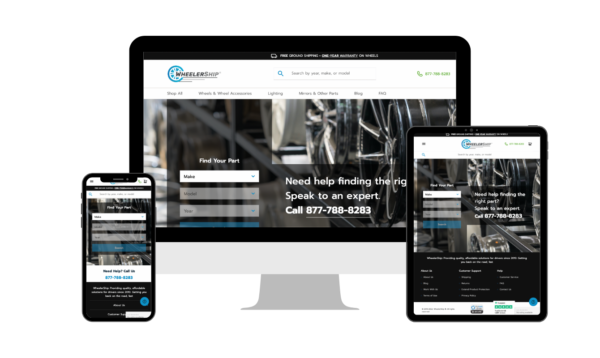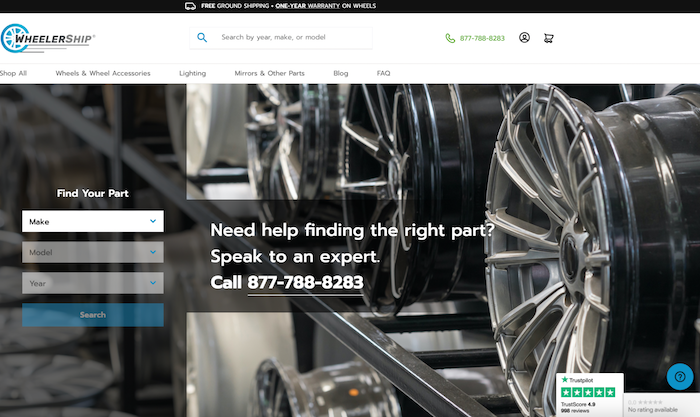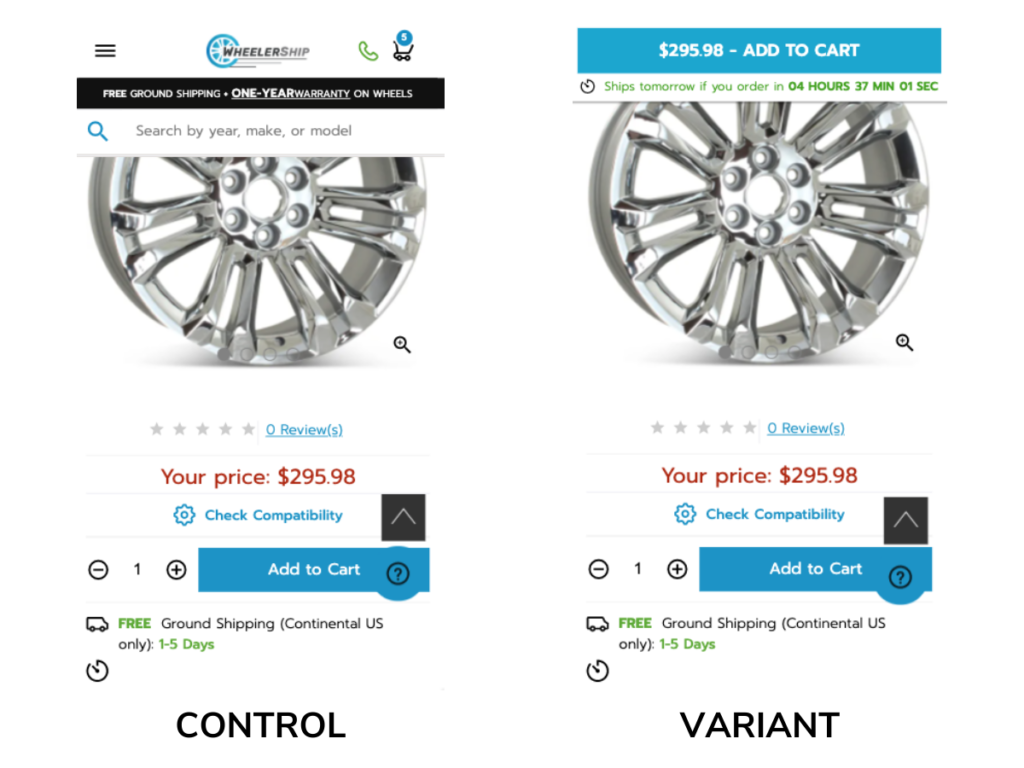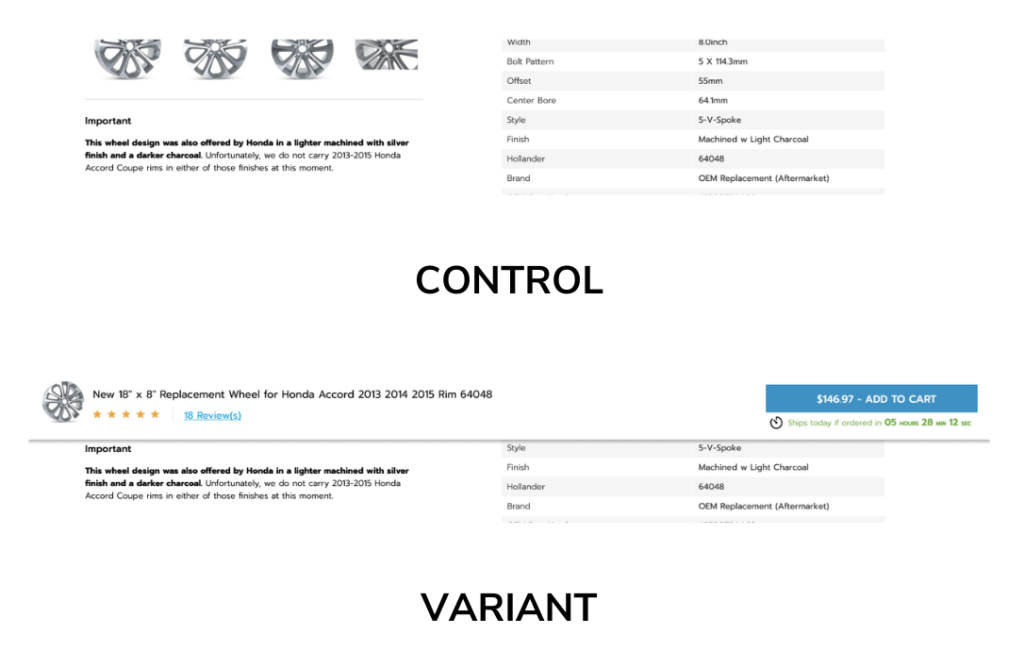
Little-by-little: small steps that make a big difference (like over $2 million in annualized revenue)
“There’s always small things, best practices, and little adjustments that you don’t have to have big debates about. But sometimes it’s less clear whether or not you’re making really impactful choices. We forget that sometimes you have to go back to the starting line.”
– Kate Cannova, Chief Business Officer at WheelerShip
When a website replatforming was in the works, Kate Cannova, Chief Business Officer at WheelerShip, made a decision that would have made others quiver in their boots: go right back to basics.
A forced transition to Magento 2 presented plenty of challenges, but resulted in many opportunities and hard-won successes. For example, Kate was able to evolve WheelerShip’s overall marketing strategy, including shifting to a customer experience model that focused on longevity.
Here, you’ll find out how Kate and WheelerShip’s long-term partnership with our team at The Good has generated results like:
- A 400% increase in desktop conversion rates
- Over $2MM in annualized revenue gains
- A harmonious fit that leaves everyone feeling jazzed after every meeting
Leading with empathy for a customer-first experience
Imagine you hit a pothole, crack your wheel rim, and need to replace it. You’re tasked with finding something that matches what’s already on your car, but you don’t want to have to pay an arm and a leg to do it.
That’s where WheelerShip helps with its original equipment replacement.

“You’re not going to find things that spin or light up, but if you borrow mom and dad’s Mercedes while they’re out of town and you break the wheel and need to replace it before they get home, you can do that with us for a lot less money than you would spend at a dealership,” says Kate.
By selling directly to the consumer, the brand puts the purchasing power back into the hands of the customer, allowing them to research what parts they need for their specific car and buy it at a much more favorable price.
Today, the brand is a leading ecommerce retailer and wholesale distributor, shipping thousands of orders per month.
Unlike, say, the jewelry industry or beauty market, consumers who come to WheelerShip are already in a heightened state of stress. They might be frustrated, scared, at the end of their tether, and unable to continue with their daily lives without their car. As such, it’s been important for Kate and WheelerShip to lead with empathy and deliver every piece of information possible to a customer so they can make an informed decision.
“We have to remove hurdles and barriers for the customer to have an easy purchasing experience,” says Kate. “So we make sure we facilitate the purchase in a way that feels human. Of course, we want the website to be great, but people are always going to have questions, and a human connection allows them to feel confident that the product they’re buying is the right one and, of course, high-quality.”
The union of The Good and WheelerShip was, in part, kismet. WheelerShip’s founders happened to submit their website for review at a conference Jon was speaking at and it was chosen, leading to a landing page teardown.
Back when we first joined forces, the brand was focused on one-off purchases, “one-time wheel buyers” as they dubbed it. With WheelerShip now more focused on longevity, our partnership has found similar focus when it comes to identifying and prioritizing projects that meet those objectives. Through the following services and a four-year partnership, we’ve been able to experiment with key ways to keep customers coming back and increase their lifetime value with the brand:
- Conversion Growth Program™ – Monthly testing and optimization
- Data Integrity – Cleaning up Google Analytics data to get better attribution for marketing campaigns and make more confident, data-driven decisions going forward
- Supporting Website Migration – Ensuring learnings from Magento 1 were translated to Magento 2, as appropriate, but also evaluating and validating the redesign in real-time to optimize the launch
- Website Redesign – Supporting a re-branding, re-facing, and new site structure that came with the platform migration
Creating a cohesive ecosystem out of siloed activities and a scattered marketing strategy
Kate joined WheelerShip when everything was up in the air. The pandemic was in full swing, bringing with it global supply chain issues and a fear of the unknown. “We started to really reframe the thinking about long-term moves, switching from a customer service model to a customer experience model, which is a palpable shift. It’s a philosophical shift and a behavioral shift,” says Kate.
But for someone whose natural state of being is data-driven decision making and who is a self-proclaimed nerd about numbers, it was important for Kate to take strategic steps in the right direction without disregarding the need for human connection that really ramped up during the pandemic.
“We try to lead with the human experience,” Kate admits. “Obviously, that has to translate to numbers in some way or another. But if we’re not providing a certain kind of experience, then the numbers won’t follow.”
At the time, there wasn’t that extra layer of customer experience and the team wasn’t evaluating the customer journey from end to end, so the data-driven and strategic methodology behind the Conversion Growth Program™ seemed like the perfect solution.
Kate was determined to delve into what made customers come back, how they could encourage repeat conversions, and what would make it easier for customers to purchase again once they had a new car or recommend the brand to their friends and family.
“I was really interested in taking the step toward evaluating the work that we were doing and approaching it as more of an ecosystem,” Kate describes, explaining that the activities of WheelerShip’s past were inherently siloed with no real cohesive marketing strategy.
As well as identifying the small steps the brand could take to tighten up conversions and nurture long-term loyalty, the Conversion Growth Program™ also focused on high-level ROI gains. Over the course of four years, testing and optimization have earned WheelerShip $2MM+ in additional annualized revenue.
In one experiment, analytics showed us that users were spending on average less than 1 minute on product pages.
Conducting customer interviews revealed that their priorities were:
- To verify that a product would match their vehicle
- To get products immediately, since often their vehicle was out of commission until the product arrived
We hypothesized that free, expedited shipping was a competitive differentiator, and that by surfacing shipping incentives, we could win out over competitors with longer lead times.
We tested adding a shipping timer near a sticky add to cart button and this resulted in an increase in both users adding products to the cart and a 5% uplift in overall transactions.
Mobile:

Desktop:

We also increased engagement on WheelerShip’s online compatibility checker by overhauling the placement of the tool and the form fields, as well as asking customers for their feedback. Switching up the placement of product reviews and restyling them increased their visibility, and we decreased cart abandonment and streamlined the checkout process by testing various add-to-cart feedback methods.
Betrayed by Google Analytics: uncovering bad data and asking “where do we even go from here?”
The first step of the Conversion Growth Program™ involves a comprehensive audit which is where the cracks started to show. Data wasn’t lining up, making it increasingly difficult to decide on basic changes–Kate said it felt like Google Analytics was betraying her.
“You can see that the data isn’t right, that things aren’t being captured properly, that transactions are not falling into the source medium bucket that they’re supposed to be. In iteration one, there was aggregate data and now, in iteration two, we’d trifurcated our channels but there wasn’t a good way to get year over year numbers. It was a real point of stress.”
It meant that the recommendations for conversion optimization were based on dud data. If your Magento receipts and QuickBooks receipts aren’t backing up what you’re seeing, you know that something’s wrong, and that’s exactly the predicament WheelerShip found itself in.
While it might seem daunting for many clients, Kate insisted that we slow down to speed up, and we agreed that we would focus on “cleaning house” when it came to data integrity before running any further tests.
The data needed to be squeaky clean before we could revisit optimization prospects–something a lot of agencies wouldn’t do.
We’ve seen some agencies grabbing what they can from bad data, but we knew it would cause problems, so as part of the process, we made sure everything was wired up correctly in GA so that the decisions they made moving forward were based on fact.
“Magento forced our hand”– transitioning to a new platform at the peak of a pandemic
“We did not have a lofty goal when we migrated the site,” admits Kate. “Initially, the only goal we had was don’t lose ground. If we can just maintain our current conversion rate, we can consider this transition a success.”
Famous last words? Perhaps.
When WheelerShip was forced to transition from Magento 1 to Magento 2 after the platform discontinued its first iteration, they knew it wouldn’t be a simple case of transferring data across – but they weren’t anticipating the leap to be as demanding as it ended up.
We worked closely with the WheelerShip team (including their development partners) to reconstruct the entire site and apply a fresh new brand to their web presence. Using a combination of team interviews, user testing sessions, and an audit of their analytics, we collaborated to build an entirely new purchasing experience that was even more customer-centric.
When you’re working with a whole new platform trying to implement the same tricks as before, it can often feel like you’re trying to jam a square peg into a round hole.
It became clear quite quickly that old methods weren’t cutting it anymore.
“Sometimes we forget that we have to go back to the starting line. We realized we should actually just treat this as a new site because there’s so much that’s different.”
While we incorporated many of the learnings and winning variants from the previous iteration that we had hypothesized and tested, it became apparent that a step back and a re-evaluation were necessary if we wanted to make tracks forward.
There were still things that seemed to be mysteriously underperforming and, for both Kate and us, there were three main questions:
- Where are visitors dropping out of the funnel?
- Why are visitors bouncing?
- What should we do about it?
Separating technical problems from experience problems was a defining moment for Kate, and we were then able to go all the way back to the top of the funnel and start from scratch, building out the new customer-centric experience from top to bottom.
Firstly, we turned around a post-launch hit to traffic by tackling low-hanging fruit in the purchase journey and prioritizing micro-frustrations that users were facing–this included activities like removing bugs, improving slow load times, and mitigating unreliable search functionality.
Once the low-hanging fruit had been addressed, we tackled transaction performance issues that put unnecessary barriers between the customers and their ability to successfully complete a purchase.
For example, customers had expressed difficulty reading the contents of their cart, which led them to abandon checkout, while others struggled with inconsistent validation that affected their ability to checkout. Knowing WheelerShip would eventually move away from Magento’s native checkout function, addressing these immediate customer pain points was essential in the interim, so we overhauled the checkout process by focusing on telegraphic user experience and a fool-proof transaction flow–something that had been tricky in the previous iteration.

Improving 1% every day and making the most of a four-year partnership
The changes to WheelerShip’s site in the rebrand were so significant that we’re now looking at it as a completely different site. What worked before is no longer getting the same results, and it’s been a process of stripping back everything we thought we knew and starting again from scratch.
For a brand that considers itself “too small to be a big business and too big to be a small business,” joining forces with an experienced and deeply knowledgeable CRO agency was a no-brainer. Without the resources to hire a full-time conversion team, WheelerShip has been able to lean on us for four years and counting.
“It makes such a huge difference to know that you’re not alone and that there are other people on your team who have a vested interest in the success of your business,” says Kate. Even after working together for so long, we’re continuing to find ways to add value to our partnership with regular tests and optimization tweaks across the site.
It’s been a breath of fresh air working with a partner like Kate and the WheelerShip team who understand the need to look at the new site through a fresh lens instead of just picking up where we left off, even if it has been a learning curve for both parties.
Creating a conversion-minded dream team: how our long-term partnership led to 400% higher conversion rates
The Conversion Growth Program™ was a crucial component of WheelerShip’s transition from Magento 1 to Magento 2, and we were there for the brand during its toughest times–a global pandemic and a worldwide shipping crisis, for starters. By working together as a unified team, we’ve been able to generate incredible results:
- Desktop conversion rates up 400%
- Mobile conversion rates have doubled
- Over $2 million in annualized revenue gain
For us (and for Kate and the team), the numbers are great but they aren’t everything. The shift towards a more human-centric approach to business, both externally and internally, is neatly aligned with our own customer-first philosophy, which is why we’ve been able to work so harmoniously with WheelerShip.
Today, the family-owned business has an ever-stronger alignment with its company values–something that our goal of total partnership has managed to foster.
We’ve been fortunate to have a positive impact on so many areas of WheelerShip’s business and have been able to run dozens of tests that their 19-strong team doesn’t have the time for.
But, even after years of working together, we’re still finding ways to add value to the customer experience and help Kate and the team get “1% better every day”.
“Obviously I appreciate the fact that our desktop conversion rate is up 400%. I love that, it’s great. And I love that our mobile conversion rate has doubled, that’s amazing,” says Kate.
“But it’s not just about the outcomes. It’s also about how we get there. There’s this misconception that if you’re a small business you don’t get to have resources like The Good, and it’s just not true. You don’t have to be an ecommerce giant to be able to work with good, smart people who are invested in making your business more successful.”
Interested in learning the laws of optimization?
Opting In To Optimization is a set of principles that will help digital leaders capitalize on unprecedented market demand and build sustainable, thriving businesses.

About the Author
Jon MacDonald
Jon MacDonald is founder and President of The Good, a digital experience optimization firm that has achieved results for some of the largest companies including Adobe, Nike, Xerox, Verizon, Intel and more. Jon regularly contributes to publications like Entrepreneur and Inc.